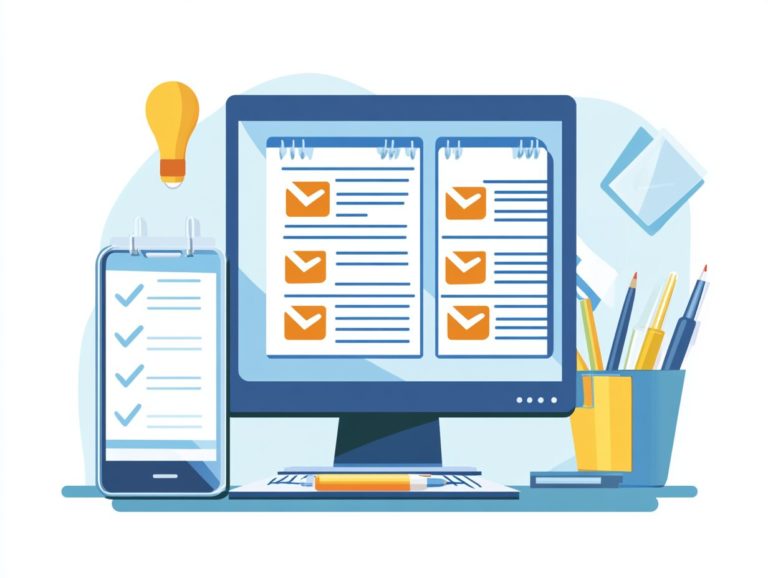“10 Time-Saving Tips for Efficient To-Do Lists”
Feeling overwhelmed by an endless task list? You re certainly not alone.
Harnessing the power of effective to-do lists can significantly boost your productivity and manage your stress levels. This article delves into ten practical tips designed to streamline your to-do list, covering everything from prioritizing tasks and setting realistic deadlines to leveraging digital tools.
It also highlights common pitfalls to steer clear of. You will also see how a well-organized to-do list improves your mental well-being.
Continue reading to transform your approach to managing tasks!
Contents
- Key Takeaways:
- 1. Use a Digital To-Do List
- 2. Prioritize Tasks
- 3. Break Down Large Tasks into Smaller Ones
- 4. Set Realistic Deadlines
- 5. Use Time Blocks
- 6. Group Similar Tasks Together
- 7. Delegate Tasks When Possible
- 8. Use Reminders and Notifications
- 9. Review and Update Your List Regularly
- 10. Don’t Be Afraid to Say No
- How Can Efficient To-Do Lists Improve Productivity?
- What Are the Common Mistakes to Avoid When Making a To-Do List?
- How Can One Stay Motivated to Complete Tasks on Their To-Do List?
- What Are Some Tools or Apps That Can Help with To-Do Lists?
- How Can One Find a Balance Between Work and Personal Tasks on a To-Do List?
- What Are the Benefits of Using a To-Do List for Mental Health and Well-Being?
- Frequently Asked Questions
- 1. What are some tips for creating an efficient to-do list?
- 2. How can I save time when managing my to-do list?
- 3. Is it better to create a daily or weekly to-do list?
- 4. How can I stay motivated to complete my to-do list efficiently?
- 5. What should I do with tasks that I don’t have time to complete?
- 6. Are there any tools or apps that can assist with creating efficient to-do lists?
Key Takeaways:

Here are some quick tips to get you started:
- Use a digital to-do list to easily access and organize your tasks.
- Prioritize tasks and focus on completing the most important ones first.
- Break down large tasks into smaller, more manageable ones for better efficiency.
1. Use a Digital To-Do List
A digital to-do list is a critical tool for effective task management. It allows you to organize your action items effortlessly while boosting your productivity through automation and prioritization. By utilizing digital planners like Asana, ToDoist, or Trello, you can cultivate a structured environment to tackle your daily tasks more efficiently. This enables you to concentrate on your life goals and clear objectives.
These applications come equipped with features such as collaboration tools and reminder alerts, fundamentally transforming how you approach and complete tasks. For instance, in Asana, team members can collaborate on projects, assigning specific roles and deadlines that foster accountability. Meanwhile, ToDoist s reminder alerts serve as helpful nudges, keeping you on track throughout the day and prompting you to complete urgent tasks before deadlines.
This functionality allows you to categorize tasks by priority, enabling you to manage your time more intelligently. By employing these tools, you can optimize your daily schedule, reduce feelings of overwhelm, and carve out a clearer roadmap toward achieving both your short-term and long-term goals.
Try incorporating this tip into your routine today!
2. Prioritize Tasks
Prioritizing tasks is essential for mastering effective time management, allowing you to concentrate on high-impact actions that align with your main goals and life objectives. Try using strategies like the Eisenhower Matrix or the two-minute rule to boost your efficiency!
The Eisenhower Matrix distinguishes tasks across four quadrants, providing a visual framework to prioritize what is urgent versus what is important. For instance, you might place a looming work deadline in the ‘urgent and important‘ category, while routine emails could fit into the ‘not urgent but important‘ section. This helps you maintain focus on immediate responsibilities without sidelining essential long-term tasks.
The two-minute rule posits that if a task can be completed in under two minutes, you should tackle it right away to avoid the buildup of smaller tasks. By weaving these techniques into your daily routine, you ll likely discover that you manage your workload more effectively, resulting in enhanced well-being and clarity in both your personal aspirations and professional pursuits.
Don t wait! Apply these tips now to transform your productivity!
3. Break Down Large Tasks into Smaller Ones
Breaking down large tasks into smaller chunks is a savvy strategy in project management that boosts efficiency and transforms daunting goals into manageable steps. This method enables you to organize tasks effectively, turning overwhelming projects into actionable items while maintaining your momentum toward achieving your aspirations.
By segmenting larger tasks into smaller, achievable components, you can focus on completing each specific piece instead of feeling paralyzed by the enormity of the entire project. For example, when faced with the task of writing a research paper, dividing it into stages like outlining, gathering sources, and drafting sections not only simplifies the process but also enables you to track your progress in real-time.
Utilizing a digital planner to map out these smaller tasks can significantly enhance your focus and clarity, providing a structured way to monitor your accomplishments. This organized approach helps minimize procrastination, fostering a productive rhythm that ultimately allows you to reach your goals with greater ease.
Start taking control of your life today!
4. Set Realistic Deadlines
Setting realistic deadlines is crucial for mastering effective time management. It helps you achieve your objectives without unnecessary stress.
By establishing achievable timelines for your tasks, you can harmonize your daily schedule with both short-term action items and long-term life goals.
This strategy instills a sense of accomplishment and alleviates feelings of overwhelm that often come from excessive pressure. To set these deadlines effectively, evaluate the complexity of each task alongside the estimated time for completion.
Breaking larger projects into smaller, manageable components simplifies this process, enabling more precise planning.
Incorporating regular check-ins on progress into your timeline can be invaluable. This ensures your goals remain realistic as circumstances evolve. This iterative approach nurtures a more adaptive workflow, creating a healthier and more productive environment for you to thrive in.
5. Use Time Blocks
Utilizing time blocks is a highly effective time management strategy that can significantly enhance your productivity. By allocating specific periods for focused work on particular tasks or projects, you engage in a technique often referred to as time boxing.
This approach creates a structured daily schedule that minimizes distractions and maximizes efficiency. Ready to boost your productivity? Start implementing time blocks today!
By breaking your day into manageable segments, you can dedicate uninterrupted time to high-priority tasks without the constant disruptions that typically accompany multitasking.
This method encourages deeper concentration and reduces the mental fatigue that comes from switching between various tasks. Begin by identifying your peak productivity hours, when you can tackle the most challenging tasks.
Using a digital planner to visually set these blocks reinforces your commitment to the schedule, ensuring you meet important deadlines and enhancing your overall task completion rates.
6. Group Similar Tasks Together

Grouping similar tasks together is a powerful technique in task management that significantly boosts your productivity by minimizing context switching and streamlining your workflow.
This method enables you to organize tasks efficiently, allowing you to tackle related items in a single, focused session. By utilizing a digital planner, you can effortlessly visualize these batches.
Consider color-coding or categorizing activities like responding to emails, updating reports, or brainstorming ideas. For instance, instead of constantly checking emails throughout your day, dedicate a specific half-hour to this task to reduce distractions and enhance your engagement.
Setting aside uninterrupted blocks of time to conduct research or complete creative tasks can lead to higher-quality outputs and a more satisfying working rhythm. This strategic grouping lightens your mental load, facilitating smoother transitions between tasks and improving focus.
7. Delegate Tasks When Possible
Delegating tasks when possible is an essential skill in project and time management that enhances team collaboration and allows you to concentrate on higher-priority work.
By effectively distributing action items among your team members, you can ensure that all tasks are completed efficiently while making strides toward your collective goals.
This practice lightens the load for a few while enabling others to develop new skills and boosting their engagement.
To identify what can be delegated, assess your workload and pinpoint tasks that align with the strengths and abilities of your team members. Clear communication is key; setting specific expectations and outlining desired outcomes enhance accountability.
Incorporating regular check-ins throughout the process keeps everyone aligned, allowing for necessary adjustments and fostering a supportive environment where productivity can truly thrive. Start delegating today to free up your time for what really matters!
8. Use Reminders and Notifications
Using reminders and notifications is a crucial feature of digital planners that enables you to stay organized and on top of your tasks and deadlines. By setting timely alerts for your action items, you can elevate your task management game! This ensures that nothing slips through the cracks in your busy schedule.
You can customize reminders to fit your daily habits such as a morning nudge to review your priorities or weekly prompts that invite a more comprehensive look at ongoing projects.
For example, task management apps like Todoist, which helps you organize tasks, or Trello, known for its visual boards, allow you to set specific reminders that align with your deadlines. These provide notifications at key milestones.
When tackling more complex projects, create project-specific reminders to keep critical tasks front and center. This ensures timely progression. These strategic alerts promote accountability and support consistent progress, making it easier for you to achieve your personal and professional goals.
9. Review and Update Your List Regularly
Regularly reviewing and updating your to-do list is essential for maintaining effective task management. This helps ensure that you stay aligned with your objectives and life goals. This consistent reflection allows you to assess your progress, adjust your priorities, and celebrate those completed action items.
Incorporating routine reviews fosters accountability and gives you the chance to recalibrate your efforts based on evolving circumstances. Scheduling weekly or monthly check-ins can significantly enhance the relevance of your goals, making sure they align with your current projects and personal aspirations.
During these reviews, consider categorizing your tasks by urgency or importance. This can help you focus on what truly needs immediate attention. Discussing your lists with a trusted colleague or mentor can provide fresh perspectives and spark motivation, reinforcing your commitment to ongoing development and productivity.
10. Don’t Be Afraid to Say No
Mastering the art of saying no is key to focusing on your priorities and avoiding the trap of overcommitting. By clarifying your objectives and life goals, you can confidently set boundaries that facilitate better organization and task prioritization.
Establishing these personal limits enhances your productivity and nurtures a healthier work-life balance. Techniques like using polite language, expressing gratitude for opportunities, and offering brief explanations can help you decline requests without jeopardizing relationships.
The long-term benefits of prioritizing your personal goals over unnecessary commitments include reduced stress levels, increased satisfaction with your work, and a greater capacity to dedicate time and resources to what truly matters. As you learn to navigate these situations with finesse, you lay the groundwork for sustainable success and personal fulfillment.
How Can Efficient To-Do Lists Improve Productivity?
Efficient to-do lists can significantly elevate your productivity by providing a clear structure for managing tasks and action items. This clarity enables you to focus on what truly matters while sidestepping that overwhelming feeling. By harnessing digital planners and implementing effective task management strategies, you can streamline your workflow and align your daily activities with your long-term life goals.
Incorporating to-do lists creates a visual roadmap that highlights your priorities, making it easier to track your progress and maintain motivation. Digital planners enhance this process with features like reminders, deadlines, and seamless integrations with other productivity tools.
For instance, set aside specific times to work on each task, effectively minimizing distractions. Breaking larger projects into smaller, manageable steps allows you to transform daunting responsibilities into achievable objectives. Start breaking down your projects today! Turning daunting tasks into small steps makes your day more satisfying and organized!
What Are the Common Mistakes to Avoid When Making a To-Do List?

Creating a to-do list is a powerful tool for managing tasks. However, common mistakes can undermine its effectiveness and hinder your progress toward clear objectives. Avoiding pitfalls like vague action items and unrealistic deadlines is essential for reaping the full benefits of a well-structured list.
Overloading your lists with too many tasks can feel overwhelming and discourage you. This often leads to burnout and a dip in motivation. Additionally, if you fail to prioritize tasks, you risk focusing on less important activities while neglecting the critical ones.
To enhance your effectiveness, consider categorizing tasks based on urgency and importance. Regularly reviewing and updating your list ensures that it remains relevant and manageable. By adopting these best practices, you can transform your to-do lists into reliable companions that foster productivity and progress, guiding you toward achieving your goals with efficiency.
How Can One Stay Motivated to Complete Tasks on Their To-Do List?
Staying motivated to tackle tasks on your to-do list can be challenging. However, with the right strategies, you can maintain your focus on productivity goals and life objectives! Consider breaking tasks into smaller, manageable chunks and setting achievable deadlines. Celebrate those small wins these techniques can significantly elevate your motivation.
Incorporating internal motivators, like feeling good about completing a task, creates a deeper connection to the work. Meanwhile, external rewards such as recognition or tangible benefits offer enticing incentives to keep your focus sharp.
Aligning your tasks with your individual values and long-term aspirations enhances motivation even further. This alignment turns routine tasks into meaningful steps toward your larger life goals, transforming the journey into something not just productive but also profoundly rewarding.
What Are Some Tools or Apps That Can Help with To-Do Lists?
Numerous tools and apps, such as Asana, ToDoist, and Trello, provide powerful functionalities to enhance your creation and management of to-do lists. These digital planners make task management more intuitive and organized! They offer features that streamline workflows and support team collaboration, ultimately improving your overall productivity.
With a variety of customizable templates available, you can tailor your task lists to meet your specific needs. For instance, Asana allows you to create subtasks and dependencies, enabling you and your team to break down complex projects into manageable steps, ensuring no detail is overlooked.
ToDoist offers a smart scheduling feature that intelligently suggests task deadlines based on your habits and priorities. Trello, on the other hand, employs a visually appealing board system that lets you drag and drop tasks seamlessly. This is particularly effective for monitoring your progress.
By leveraging these tools, you can prioritize effectively, set reminders, and even collaborate in real-time. This ultimately leads to enhanced organization and productivity! Try one of these tools today and see how it can transform your task management!
How Can One Find a Balance Between Work and Personal Tasks on a To-Do List?
Finding a balance between work and personal tasks on your to-do list is crucial for maintaining your overall well-being and productivity. You want to ensure that neither area of your life gets neglected. By strategically organizing your tasks and setting clear priorities, you can create a daily schedule that accommodates both your professional obligations and personal aspirations.
An effective way to achieve this balance is through time blocking. This method involves dedicating specific chunks of your day to focused work or personal activities. By doing this, you minimize distractions and enhance your concentration, allowing for more efficient task completion.
Utilizing prioritization techniques, such as the Eisenhower Matrix, helps differentiate between what s urgent and what s important. Incorporating personal goals like exercising or spending quality time with family into these well-structured time blocks ensures that your personal growth remains a priority. This approach fosters a more satisfying and holistic life experience.
What Are the Benefits of Using a To-Do List for Mental Health and Well-Being?
Using a to-do list offers a wealth of benefits for your mental health and overall well-being. It grants you a sense of control and accomplishment while alleviating stress and anxiety. By organizing your tasks and action items, you can enhance your productivity and maintain a sharp focus on your life goals.
Psychological research shows that writing down your tasks can significantly ease feelings of being overwhelmed. It puts your thoughts out and clarifies your priorities. Experts recommend breaking larger tasks into smaller, manageable steps, which can dramatically reduce anxiety and make your goals feel far more attainable.
Completing even minor tasks from your list can boost your self-esteem and foster a sense of success. This is an essential component of overall mental well-being. Regularly reviewing your to-do list not only keeps you organized but also serves as a visual reminder of your progress. It reinforces positive habits and cultivates a deeper sense of fulfillment in your daily life.
Frequently Asked Questions
1. What are some tips for creating an efficient to-do list?

Some tips for creating an efficient to-do list include setting specific and achievable goals, prioritizing tasks, breaking down larger tasks into smaller ones, and using a digital or paper system that works best for you.
2. How can I save time when managing my to-do list?
To save time when managing your to-do list, try grouping similar tasks together, setting reminders or deadlines, and delegating tasks to others when possible.
3. Is it better to create a daily or weekly to-do list?
This ultimately depends on your personal preference and workflow. Some may prefer a daily list to focus on specific tasks for that day, while others may find a weekly list more helpful for planning ahead and seeing the bigger picture.
4. How can I stay motivated to complete my to-do list efficiently?
One way to stay motivated is by setting small rewards for yourself after completing a certain number of tasks. Make it a habit to check your to-do list often it s your roadmap to success!
5. What should I do with tasks that I don’t have time to complete?
If you have tasks that you don’t have time to complete, consider delegating them to others or reassessing their priority. You can also add them to a future to-do list if they are not time-sensitive.
6. Are there any tools or apps that can assist with creating efficient to-do lists?
Yes, there are many digital tools and apps available, such as Trello, Todoist, and Asana, that can help with organizing and managing your to-do lists. It may be helpful to research and try out different options to find the one that best fits your needs.
Ready to take control of your tasks? Start writing your to-do list now and unlock your potential!






